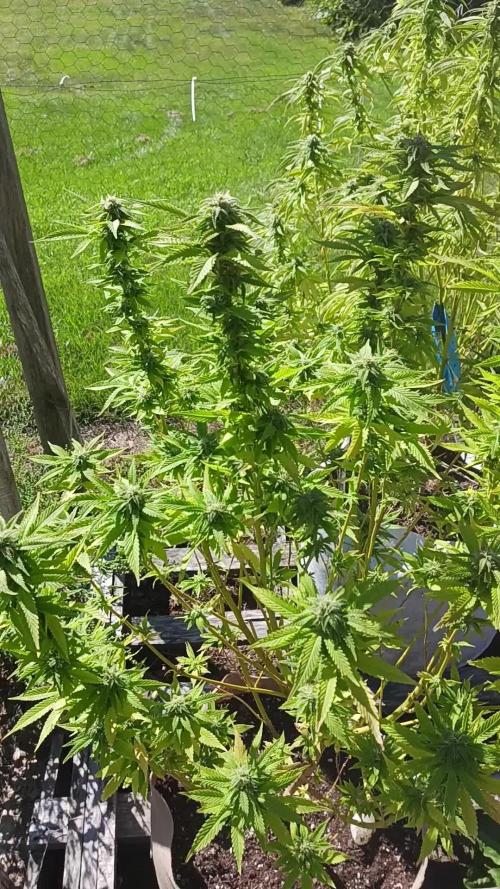The Grow Awards 2026 🏆 





























Likes
24
Share


@Chow_13
Follow
Day 50 - EC 1016, PH 6.3 Added PH down. Created a grow video and did a bunch of defoliation. Removed all of the lower bud sites.
Day 51 - EC 1025, PH 5.78. Brewed a 7L batch with 3ml Gro, 2ml Micro and 1ml of Bloom( EC 543 ) PH down to 5.8 added 4L to the reservoir. Noticed the top leaves are getting a bit of yellowing in between the veins, I think its light burn.
Day 52 - EC 0852, PH 5.73. Thinking of letting her heal up a bit more then I am going to try to supercrop her.
Day 53 - EC 0795, PH 4.68. Added PH up and the rest of the brewed batch from day 51.
Day 54 - EC 0783, PH 6.15.
Day 55 - EC 0816, PH 5.77. added PH up
Day 56 - EC 0987, PH 5.09. Brewed a 6L batch with 2ml Gro, 2ml Micro 2ml Bloom( EC 531 ) Added a bit of PH down to bring it to 6.8. Added 3L to the reservoir then began
Supercropping every one of her nodes. Went a little crazy, lol. But cut her height a lot . Didn't tie anything down so were gonna see how she recovers.
After that the readings were EC 0955, PH 5.98
------------------------------------------------------------------------------------------------------------------------------------
Now this was a big week. First I had a little bit of fun and entered the holiday video contest. Decided to do it with the counter saying 1 day left and uploaded it at 4:am in fear I would not get anything entered. Later to find out after the "Days left" counter it shows hours so I could of gotten better video. Still had a lot of fun doing it. Also did a defoliation while recording the video so the start has it pre-defoliation and the end you see everything I cut out. I don't think she liked what I did because the days after she started showing yellowing, PH kept on dropping dramatically. So what did I do. I bent every single side shoot of growth!!.Supercroped. Hope she heals well.
Likes
10
Share


@SnoopyShaggy
Follow
3 autoflowers which is Outlaw Amnesia, Purple Punch, and Strawberry cough are well undergoing veg stage. Since these 3 plant genetics breeded are a mix of 2-3 different strains. The grow results from this seed breeders are amazing no complaints.
I am really looking forward growing single strain very soon from international seedbanks asap once i finish experimenting all of my custom breeder strains.
I am having a crazy overthinking with 2 of my AK47 since they are seeds generated from a hermie AK47 autoflower.
The issue is more of a thought process whether the plant will flower since these 2 of them are under 1 tent with 3 Autoflowers😂, i hope they will follow the autoflower traits and not photoperiod.
If they are not flowering, i was informed to flip the light to 12-12,
If this situation happens, the only possible outcome i can think of is to defoliate/shwazz them and then flip them sf2000 to 12-12 right only i harvested 3 of the Autoflowers.
Officially planted these babies on Nov 9, i will log into GD diaries every Sunday.
Officially added 0.5ml of BigBud per litre, a very minute ammount just to top up some P and K since 3 plants are entering preflowering soon.
Likes
60
Share


@SooSan
Follow
12/12 + 130 jours
Vu qu’il y a 16 plantes mais que sur growdiaries on ne peut mettre que 8 variétés j'ai divisé en 2 diaries pour le bas de la tente
1️⃣
🏠 90x60x90
☀️ FC-E 4800 => puissance a 60%
🍁
Black Bomb / Philosopher Seed
Amnesia Lemon / PEV Seeds
Amnesia Lemon /PEV Seeds
Blueberry / PEV Seeds
Blueberry / 00 Seeds = 17g
Wappa / Paradise Seed = 11g
Dark Phoenix / Green House Seed
Quick Sherbet / Exotic Seeds = 14,5
Mango Cream / Exotic Seeds
Banana Frosting / Sensi Seed = 11g
Hindu Kush / Sensi Seed 10,5g
Mix 1 / Sweet Seed = 26,5g
Mix 2 / Sweet Seed = 15g
Mix 3 / Sweet Seed = 22,5g
Mix 4 / Sweet Seed =
📎 https://growdiaries.com/diaries/122084-grow-journal-by-soosan
📎https://growdiaries.com/diaries/124052-grow-journal-by-soosan
2️⃣
🏠 30x60x50
☀️TS1000 => 100w = 54g
🍁
Quick Sherbet - Exotic Seed = 12g
Quick Sherbet - Exotic Seed = 12g
Quick Sherbet - Exotic Seed = 17,5g
Quick Sherbet - Exotic Seed = 12,5g
📎 https://growdiaries.com/diaries/122080-grow-journal-by-soosan
Likes
16
Share


@Jays_Not_Here_Man
Follow
Haven’t done anything, other than start a full dose regiment of nutrients this week. Working on a bigger light situation for my large tent, in the meantime space is limited 😢
Likes
11
Share


@Bluemels
Follow
Tag 123: Die Chocolate Haze befindet sich der Entreife. In einer Woche wird geerntet 😁
Likes
40
Share


@Chubbs
Follow
420Fastbuds
ApricotAuto/Week5
What up grow fam. Sorry for the late weekly update but was having some technical difficulties. This week has been eventful to say the least. My heater went out letting my Temps drop to high 40'f for a night or two and wow did the plants tell me they're angry. Definitely starting to bounce back but just goes to show the reselants of Fastbuds genetics. I lollipoped and did one more defoliation this week so hopefully flower stage will be smooth sailing. All in all Happy Growing
Likes
17
Share


@masterofsmeagol
Follow
9/20 Man I've been busy. I'm sick too. Looking back at my diaries I get sick this time of year every year it seems. Once I get the important stuff done I'll put some pictures of finished product up. Sunny today and windy as hell. All the plants left seem to be doing good and look like they'll finish. The pink kush might not finish how I WANT but it's stinky and has lots of milky trichs. I'm playing with fire with this mk ultra. It's fucking done. It could get a LITTLE more amber and maybe come together a bit more but I don't know if it's smart to risk it. Frost warning in effect tonight. I'll probably check the forecast and harvest tomorrow. We're having some good weather just cold nights. Then it turns to like a 30% chance of rain for 4 or 5 days. I'll yank it before that. This actually turned out tp be a pretty good year. Haven't tested everything (especially shit in the ground) but what I have sampled I'm incredible happy with.
9/21 IT was a balmy 36° on my way to the garden. My windshield had frost on it. Surprisingly the TIGHT nugs of the pink kush and this phenome of 10th planet didn't seem to mind it. Both strains are still increasing in size, smell and trich development. Not just changing but adding more. Trichs on trichs. Very in hospital environment. It will be interesting to see what happens with these girls. We will be getting some rain. I mean we've had SOME but I mean real rain. If thays the case I'll put these in the garage for a little bit. Honestly I thought these would be goners. I've gotta get to work trimming bucking and manicuring flower. Doing a garden like this sure is an awful lot of work. But the reward is worth every penny. WATERED EVERYTHING LEFT A HALG GALLON APIECE. PROBABLY SHOULDVE GAVE A GALLON BUT THEY WERE STILL A LITTLE HEAVY.
9/22 It rained last night and we got another frost. HAD to cut a main branch of the tenth planet as it had stem rot. Lots more cold weather coming. If I could get it done and I wasnt sick and have all this other material to process I would probably pull then. It's getting really cold. We're going to be getting rain. I'll check the weather and hopfully I can just put the movable ones in the garage. Either way things will work out. Pictures that will be coming will be of the finished product!
Likes
77
Share


@SuggaShane
Follow
Only got Gorilla Cookies left. Chopped down Gorilla Zkittlez last week. Gorilla Cookies is filling out. Buds getting denser. Smell is great, like an Earthy, Berry, gasy Lemonade lol Gorilla Zkittlez looks like it’s coated in Trichromes. Smells berry. Thanks for checking out my diaries. Any questions don’t hesitate to ask. 💪🏽🌱😎
Likes
5
Share


@mobbly
Follow
Week 3: Since this is my first grow, I love to see how quickly the cannabis plant grows, and it's accelerating rapidly. They are thriving and healthy. This week, I used fertilizer for the first time, starting with half the amount recommended in the feeding schedule. 0,5/ml per liter.
Likes
27
Share


@AsNoriu
Follow
Day 79 since seed touched soil. Found some bud rot on other strains yesterday, so made early chop for #2 and #3. Both needed time, #2 needed like 3 more weeks, would be huge ;)))
Day 112 since seed touched soil. last one is done. Ganja Farmer 2024 project is over.
Happy Growing !!!
Likes
32
Share


@BreakingBud
Follow
Plants looking great. Final week, flushing with filtered water for 7- 10 days. Plants ripening nicely, very dense colas. I noticed a spider mite outbreak last week, it has spread from one plant to the a few others, not a bad infestation, today predator mites will be released onto every plant throughout flush. Predator mites have worked great in the past.
**predator mites phytoselius have been applied, hopefully they can clear up the infestation before harvest. When the plants are cut down and hung to drt any remaining mites will crawl up the stem as the plant dries. I will wrap the stem in double sided sticky tape.
Likes
8
Share


@JeyGanesha
Follow
La poderosa runtz forbidden sta per arrivare a maturazione.. ancora un paio di settimane più o meno e ci siamo...forse la lascio anche qualche giorno in più per farle creare un po' più di: CBN😜💪👍
Likes
9
Share


@RSAFirstOrganicGrow
Follow
It’s still been a trial & error process, while “training” I’m constantly afraid of hurting the plant haha.
But so far I’m satisfied, if I could get 10 decent grams out of her I’d be happy.
Weather has been picking up nicely but still some cold evenings 7-10 d.celcius.
Started feeding her some Black Strap Molasses.
I forgot to add that I’m really not sure whether she is in flowering or not. & would cutting of like 3 fan leaves be a problem?
Likes
44
Share


@Ukfarmer420
Follow
So this week i harvested the orangesherbert so sticky and stinks of orange, 50grams dry of 🔥 bud.
Curing in a big jar at 21 degrees and humidity of 60% dark cool cupboard.
Watermelon zkitles is bouncing back, the runts is doing amazing with the lst and leaf tucking.
I had to kill the purplelemonade due to it herming on me I dont have space for that so I'm going to run a ethos genetics seed in its place.
Likes
119
Share


@MrCOCO
Follow
Hi. I haven't been here for a long time because I have a lot of responsibilities in life. I added the rest of the photos as the last week...
It was a pure pleasure to meet runtz layer cake. I don't remember how much exactly it came out on the scale... But it was about 200g from the plant (+, -)... It stands out with its smell and taste. it is unique in every way and it is my top 3 in my ranking...






























